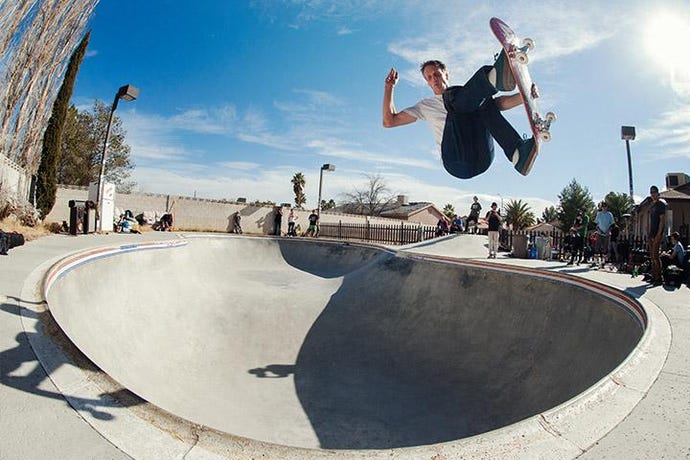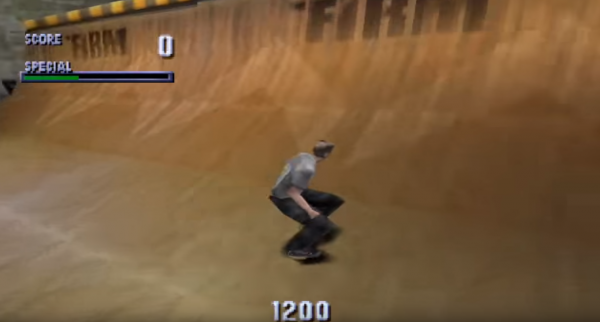
According to professional skateboarders Rodney Mullen and Chad Muska, skateboarding’s popularity is constantly fluctuating. “We’ve been watching this rollercoaster, and every decade there’s a big peak and then a valley,” Muska says. “But we haven’t felt the bottom for a while.” Since its crash in the early 1990s, skateboarding has enjoyed a slow upward trajectory. The kids from the first skateboarding boom are now in their 40s and far outnumber teenagers at skateparks.
In the late ’90s and early ’00s, rap and hip-hop were integrated into skate culture. Skate videos eschewed the cheesy VHS aesthetic and fisheye lenses in favor of faster cuts and smoother footage. Fast forward to 2020. Kids who grew up in this culture are now paying tribute to it. Jonah Hill’s directorial debut, Mid90s, is a coming-of-age film about skateboarding in the ’90s, and Louis Vuitton’s creative director Virgil Abloh now commissions professional skateboarders to design shoes for his fashion house.
The 1995 X Games brought exciting opportunities for skaters and many new sponsors. But perhaps surprisingly, the video game Tony Hawk’s Pro Skater also deserves credit. The game debuted on PlayStation in 1999 and served as a digital ramp for new skaters. It grossed over $1.4 billion and helped propel the underground culture into the mainstream, where it is now an Olympic sport. The games introduced a generation of kids to skateboarding and immersed them in skate culture. Clothing brands and trick names became part of players’ vocabulary, and the soundtrack was filled with everything from punk rock and metal to rap and hip hop.
“The games brought skateboarding directly to the world and into so many homes,” Muska says. “The cultural impact they had on skateboarding was so huge. I can’t even put a number on it.”
Considered one of the most influential skaters of all time, Mullen was a playable character in Tony Hawk’s Pro Skater 2. He knows firsthand how life-changing those games were. He was ready to give up skateboarding before Hawk asked him to join the game.
“I called him and said, ‘Hey, I’m thinking about quitting. I don’t know if that’s a sign that I broke my ankle or not,” Mullen said. Hawk’s answer surprised him. “I hurt my ankle? So what. That doesn’t mean anything. Oh, by the way, do you want to be in my game?” When Mullen hit the road the following summer, a month after the game’s release, more people were paying attention to him than ever before. “It was crazy,” he says.
He remembers being accosted by two big guys during a late-night skate session in a rough neighborhood in Los Angeles. “The look in their eyes told me this was going to be big,” Mullen says. “And all of a sudden one of them said, Wait a minute, aren’t you in the game? He imitated the body language of a little kid and asked me if I could do this trick or that trick. It was crazy.”
“What I’m trying to say,” Mullen continues, “is that the release of the game not only upended the existing community and our place within it, but it also gave outsiders recognition and respect for what skating has taught us; especially when it comes to language.” It spoke to me. They taught people our language…”
I remember when the game came out, people thought, “Oh, this is just going to appeal to all the nerds sitting on their couches playing.”
Musca believes the Tony Hawk games helped break the stereotypes of skateboarders at the time. “When someone first thought of skateboarding, they thought white, punk rock, and California,” Musca says. “Cultural barriers were broken.”

Lizzy Armanto, a 27-year-old pro skater, is the latest addition to the virtual roster for the remastered Tony Hawk Games, released this month. An X Games gold medalist at just 20 years old, Armanto has appeared on the covers of skateboarding magazines Thrasher and Transworld, and was the first woman to complete Tony Hawk’s infamous 360-degree loop. Armanto has been vocal in denouncing prejudice in the skate scene. The emotional video, titled “Above the Noise,” shows Armanto addressing sexism on a daily basis as she reads social media comments alongside skaters Jen Sotoje and Samaria Brevard.
“Women and their appearance are heavily scrutinized, yet people are not as careful with what they say,” Armanto says. “I feel really lucky and very grateful to have come from a skateboarding background, because it helps you grow a thick skin, both physically and mentally.”
A skateboarding forward, Armanto believes the scene is making positive progress. “I definitely think something is changing,” Armanto says. “Even when I first started, some of my family members would say, ‘You’re too beautiful to skateboard,’ and my grandmother would say, ‘You’re too fragile.’” Skateboarding, no matter where you’re from.
“It’s really important that [skateboarding] is diverse and inclusive of people from all over the world because that’s what skateboarding is, at its core,” Armanto says. “It’s always about what you do, not who you are.”
“Skateboarding is like music,” Musca says. “You can be a pool skater or a street skater. You can be a vert skater or a park skater. You can be an emo skater who likes The Cure or a SoundCloud rapper who listens to underground rap.” That’s what makes a real professional skateboarder – when kids look up to that person as a role model and want to copy their style, dress like them, skate like them, listen to the same music as them.”
The Olympics put skateboarding into the realm of sports, but for skaters, skateboarding has always been an art form where style and movement innovation can be seen, whether it’s a freestyle skateboarder like Isamu Yamamoto or a drop that puts your life on the line, like Aaron Homoki.
“I absolutely support the idea that skateboarding is not a sport,” says Mullen. “We are an entire culture that has a certain language and way of doing things and expresses who we are, and it’s not just some competition that happens every year…Street league, the Olympics, good luck, but that’s not the whole picture.”

Leave a Reply